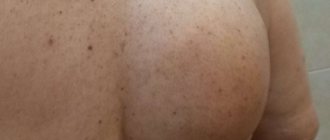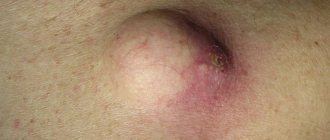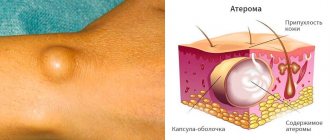The Center for Maxillofacial Surgery and Implantology has created excellent conditions for effective diagnosis and removal of any benign tumors on the face.
Our highly qualified surgeons specialize in operations of any complexity, have extensive experience and master the most modern techniques for removing tumors, such as lipoma.
Why do lipomas appear on the face?
This benign tumor is popularly called a wen. However, this name has taken root so much that you can often hear it from the doctors themselves. This does not change the essence - this neoplasm does not pose any danger to a person, but at the same time it can seriously spoil his appearance. Unfortunately, contrary to popular belief, it is impossible to fight lipomas with medication, so in any case you will have to go to specialized clinics to remove this defect. So it is better not to waste time on various “folk” methods of getting rid of this disease and immediately come to specialists, get professional advice and seriously begin to solve this purely cosmetic problem.
Lipoma on the face, as a rule, occurs in people over 30 years of age and is a benign formation (contrary to popular belief, they are not harbingers of a cancerous tumor) from an accumulation of fat cells. It grows slowly, asymptomatically and painlessly (in rare cases, when the tumor grows, it can begin to cause noticeable pain, for example, by squeezing a nerve), and is largely only a cosmetic defect.
It is impossible to accurately determine the causes of the appearance of wen. Their systemic appearance indicates a genetically inherited disease, hypomatosis. The most common version of the occurrence of wen associates their appearance with a disruption of the metabolic processes occurring in the adipose tissue of the face. Some experts believe that this may be the result of diseases of the liver, pituitary gland, thyroid and pancreas. The wen can be located on any part of the body: on the back, legs, shoulders, hips. The tumor is localized in the upper layers of the skin; very rarely it can appear in internal organs that have a fatty layer. Defects on the face are usually more noticeable and therefore most often require treatment.
Wen presents problems only from an aesthetic point of view. Most often it is localized in the upper part of the face - on the forehead or eyelids, and is a soft rolling painless tubercle. In its external manifestation, this disease is similar to another skin disease - atheroma, which occurs as a result of blockage of the sebaceous glands, but is a fundamentally different neoplasm.
Diagnosis and examination of lipomas before surgery, in the vast majority of cases, is carried out only for large lipoma sizes. The most reliable diagnostic method is ultrasound, but it is done only in cases where the tumor has grown to a serious size in order to determine its boundaries. If there is doubt about its nature, a puncture biopsy is performed - a puncture followed by sampling of material. Then a cytological examination is performed, during which the nature of the tumor is determined. In these cases, we are talking about planning surgical removal of large wen that causes pain or various kinds of inconvenience. In all other cases, visual inspection and palpation are sufficient.
Symptoms
The wen on the forehead has a dense consistency. During palpation of the lipoma, the patient does not experience pain. There is no connection between the neoplasm and neighboring tissues, so when pressure is applied it moves to the side.
Why can our articles be trusted?
We make health information clear, accessible and relevant.
- All articles are checked by practicing doctors.
- We take scientific literature and the latest research as a basis.
- We publish detailed articles that answer all questions.
Mostly single lipomas appear on the forehead. If several wen are formed, over time they can form a large tumor.
Inflammation of the wen
Inflammation of the wen is a pathological condition manifested by painful sensations, an increase in size, and an increase in body temperature.
Neoplasms are characterized by slow growth. The following can accelerate their development:
- injuries;
- constant pressure or friction;
- bruises.
Lipomas on the body do not pose a danger to the body. They create cosmetic discomfort. Due to the fact that the wen is located on the forehead, during hygiene procedures there is a possibility of damage to the skin on the surface of the neoplasm.
This can lead to infection of the lipoma. The inside of the tumor is filled with fatty tissue. Such conditions are favorable for the development of pathogenic microorganisms.
If a lipoma is infected with bacterial microflora, there is a danger of infection entering the brain. The presence of an inflammatory process in the wen can be determined by the pain that occurs when pressure is applied. Reddened skin and itching also indicate infection.
Active growth of a wen in rare cases indicates its degeneration into liposarcoma. When pressing on such a tumor, the patient experiences pain. Liposarcoma, unlike a wen, connects with neighboring tissues. Therefore, during palpation it remains motionless.
Surgical treatment for lipomas on the face
To cure a lipoma, in this case, means to remove it surgically under local or general anesthesia. Such an intervention can only be entrusted to a specialist, and under no circumstances should you do it yourself at home. Firstly, there is a risk of infection and inflammation, which will require separate treatment. Secondly, cause complications and re-occurrence of multiple lipomas. Despite the apparent simplicity of removing this benign tumor on the face, it must be carried out in the sterile conditions of a medical center using special methods.
The surgical method is used in cases where the size of the tumor exceeds 3 cm. However, not only the large size of the fat is a direct indication for surgery, since it can increase in size and begin to cause noticeable pain, for example, by squeezing a nerve. The operation is performed using local anesthesia and involves complete removal of the tumor.
Surgical intervention is radical therapy, which is carried out in the following cases:
- serious cosmetic defect;
- big sizes;
- disruption of the functions of neighboring organs due to compression of them by an overgrown tumor;
- rapid growth of lipoma.
This method is rarely used to remove fatty tissue, since small noticeable scars remain after the operation. Moreover, there are many minimally invasive ways to remove these tumors. It is about them that will be discussed further.
Modern medicine makes it possible to remove lipomas under the control of a special device - an endoscope, which allows you to fully monitor the progress of the operation. In this case, no signs of the operation remain on the patient’s face. The endoscope is inserted into the wen, making a small incision on it. Then the wen itself is removed from under the skin using a special tool. If possible, the incision is made not on the wen itself, but on the nearest less noticeable area of the face - under the hair or on a skin fold. After the operation, the patient is under medical supervision for two weeks.
To remove a lipoma, a puncture-aspiration method can also be used, which involves inserting a special needle into the tumor and then removing its contents. No stitches are required; the patient can return home a few hours after the operation. The main disadvantage of this method is that it does not guarantee complete removal of the tumor. A relapse is possible because after the procedure, a certain amount of wen contents may remain under the skin of the face. The success of the operation entirely depends on the qualifications and skill of the specialist.
Reasons for appearance
The causes of wen are not fully understood. But experts identify a number of the following factors that contribute to the formation of benign lipomas:
- Thickening of the consistency of sebum and its stagnation in certain places.
- Increased oily skin.
- Gastrointestinal diseases.
- Genetic factor.
- Metabolic disorders and excess weight.
- Liver and kidney diseases.
- Malfunction of the endocrine system.
- Diabetes.
- Thyroid diseases.
- Failure to comply with hygiene rules - in the absence of frequent water procedures, sebum released outward contributes to blockage of the ducts of the sebaceous glands, eventually forming wen.
Important! In the case of a genetic predisposition, wen can appear out of the blue in a healthy person. So, if one of the parents (or both) is prone to the formation of lipomas, then there is a high probability that the child will also have them. Subcutaneous formations can appear spontaneously and disappear just as unexpectedly. In this case, only the skin is subject to treatment.
Alternative methods for removing lipomas
The surgical method for removing a lipoma is used, as mentioned above, if it is of significant size. As a result of the operation, a barely noticeable light trace remains; to avoid it, it is better to remove the tumor while it is small and you can use laser or radio wave removal.
Laser therapy is one of the modern and highly effective methods. It is used to remove small and medium-sized subcutaneous wen and is performed under local anesthesia. With this method of lipoma removal, the tissues surrounding it are practically not affected. As a result, healing after a course of laser therapy occurs much faster, and cosmetic defects are practically eliminated. Each of them is removed, literally, pointwise and without a trace, leaving no scars, even barely noticeable ones, and, in general, without affecting the surrounding tissues.
Treatment of lipomas on the face can be carried out using the most advanced method to date - using the Surgitron radio wave radiosurgical device. This method has proven itself to be excellent for removing small subcutaneous wen on the face. One of its main advantages, undoubtedly, is the fact that with its use there are practically no relapses. Using this method, lipomas are removed painlessly and bloodlessly; no rehabilitation period is required.
Specialists at the Center for Oral and Maxillofacial Surgery and Implantology recommend that if any neoplasms are detected on the face, even something as harmless as wen, you immediately consult a doctor in order to carry out the full range of measures to remove them as quickly and efficiently as possible.
Diagnostics
To diagnose a wen on the forehead, an external examination is often sufficient. Additionally, radiography and ultrasound are prescribed. The last method is considered the most informative, since through it it is possible to find out the following circumstances:
- the true size of the tumor;
- the presence of fat cells inside the lipoma;
- exclude signs of liposarcoma.
In addition to ultrasound, a fine-needle biopsy is prescribed, which makes it possible to accurately identify a malignant neoplasm.
Prevention
First of all, doctors recommend leading a healthy lifestyle and eating right. The diet should include only high-quality foods, vitamins and minerals. You should also follow the rules of hygiene and use high-quality cosmetics.
Wen on the nose most often appears in women, but men are also susceptible to their occurrence. In most cases, they cause moral discomfort, as they spoil the appearance.
You should get rid of wen immediately after they appear, as over time they grow and more unpleasant symptoms appear. In this case, removal occurs surgically.
Why is it dangerous to squeeze out a wen?
It is necessary to understand that a wen has fundamental differences from ordinary acne, so squeezing it out is strictly prohibited.
Failure to comply with this rule can lead to the following negative consequences:
- The persistence of noticeable scars on the nose can be very difficult to eliminate: it requires both a certain amount of time and a course of procedures, as well as financial investments.
- Infection in the wound and the appearance of purulent inflammation can lead to the most severe complications.
- The occurrence of relapses. This is due to the structural features of the wen: when squeezed out, only its contents come out, but a capsule remains inside, which is the outer shell of the neoplasm.
- Damage to blood vessels during the squeezing process, which can lead to severe bleeding.










